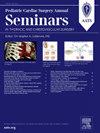冠状动脉异常起始的最佳手术技术是什么?
Q2 Medicine
引用次数: 0
摘要
冠状动脉异常起源(AAOCA)与心源性猝死风险增加相关。多种外科技术已经发展到治疗这种异常。治疗AAOCA的最佳手术技术尚不清楚,但因患者具体解剖结构而异。我们讨论了三种不同的技术:拆除内段,冠状动脉横断和再植,以及创建新口。当异常冠状动脉的壁内段较长且位于主动脉瓣上方时,去顶手术是最佳选择。如果主动脉瓣下方有一段较长的壁内段,应考虑在适当的窦处部分切除冠状动脉以形成新口。冠状动脉再造术的最佳选择是:壁内段位于主动脉瓣下方,但长度不足以形成新开口,或者壁内段较短或不存在。手术技术应根据患者的解剖结构进行个体化,并解决所有潜在的解剖罪魁祸首。本文章由计算机程序翻译,如有差异,请以英文原文为准。
What is the Optimal Surgical Technique for Anomalous Aortic Origin of a Coronary Artery?
Anomalous aortic origin of a coronary artery (AAOCA) is associated with an increased risk of sudden cardiac death. Multiple surgical techniques have been developed to treat this anomaly. The optimal surgical technique to treat AAOCA is unclear but varies depending on the specific patient anatomy. We discuss 3 different techniques: unroofing of an intramural segment, coronary transection and reimplantation, and creation of a neo-ostium. Unroofing is optimal when the anomalous coronary has a long intramural segment that travels above the aortic valve. Creation of a neo-ostium by partially unroofing the coronary at the appropriate sinus should be considered if there is a long intramural segment that travels below the aortic valve. Coronary reimplantation is optimal if the intramural segment travels below the aortic valve but is not long enough for creation of a neo-ostium, or if there is a short or nonexistent intramural segment. Surgical technique should be individualized based on patient anatomy, and all potential anatomic culprits addressed.
求助全文
通过发布文献求助,成功后即可免费获取论文全文。
去求助
来源期刊

Pediatric Cardiac Surgery Annual
Medicine-Surgery
CiteScore
3.80
自引率
0.00%
发文量
7
期刊介绍:
The Pediatric Cardiac Surgery Annual is a companion to Seminars in Thoracic and Cardiovascular Surgery . Together with the Seminars, the Annual provides complete coverage of the specialty by focusing on important developments in pediatric cardiac surgery. Each annual volume has an expert guest editor who invites prominent surgeons to review the areas of greatest change in pediatric cardiac surgery during the year. Topics include 1) Complete Atrioventricular Canal; 2) New Concepts of Cardiac Anatomy and Function -- The Helical Heart; 3) Valve Reconstruction (Replacement) in Congenital Heart Disease; 4) Evolving Developments in Congenital Heart Surgery.
 求助内容:
求助内容: 应助结果提醒方式:
应助结果提醒方式:


